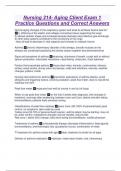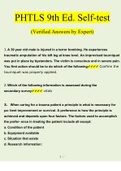Nursing 214- Aging Client Exam 1
Practice Questions and Correct Answers
Normal aging changes of the respiratory system and what do all these factors lead to?
✅1) stiffening of the elastin and collagen connective tissue supporting the lungs
2) altered alveolar shape and increased alveolar diameter (less effective gas exchange)
3) other body systems contribute to the functioning of the lungs
- they all lead to decrease in vital capacity and increase in residual volume
Asthma ✅chronic inflammatory disorder of the airways, smooth muscles on the
airways are constricted squeezing the airway closers together (broncheorestrictive)
Signs and symptoms of asthma ✅wheezing, shortness of breath, cough with or without
sputum production, intercostal retractions, nasal flaring, chest pain, chest tightness
Factors that exacerbate asthma ✅house-dust mites, animals, cockroaches, tobacco
smoke, wood smoke, strong odors and sprays, colds and infections, exercise, weather
changes, pollens, molds
Nursing interventions for asthma ✅prevention (education) of asthma attacks, avoid
allergens and triggering factors, smoking cessation, peak flow meter, diary to record the
readings from pfm
Peak flow meter ✅measures how well air moves in and out of lungs
When to use peak flow meter ✅for the first 2 weeks after diagnosis, with changes in
treatment, mornings after awakening, between noon and 2 pm, before and after taking
bronchodilators, patients feels sickness coming
Classifications of peak flow readings ✅green zone: (80-100% of personal best) good
control, no symptoms, take meds as usual
Yellow zone (50-79% of personal best) caution, asthma attack may be starting, may not
be under control, medications changes may be needed, call provider
Red zone: ( below 50%) danger, take short acting bronchodilators, notifies physician
Treatments of asthma ✅corticosteroids therapy (decrease inflammation), beta agonist
bronchodilators, anticholinergics (dry up patients mucus), combination of meds
T/f treatment for asthma varies with age ✅false, treatment is similar for all ages
Delivery of asthma medication ✅nebulizer, meter dose inhaler, oral, intravenous
, Nursing diagnoses associated with asthma ✅activity intolerance, ineffective airway
clearance, ineffective breathing patterns (r/t increased respiratory rate), altered tissue
perfusion (aeb low o2 saturation and synopsis), ineffective management of therapeutic
regimen
Chronic obstructive pulmonary disease (copd) ✅increased resistance to airflow due to
obstruction, difficulty exhaling due to airway narrowing or loss of elastic recoil
2 types of copd ✅emphysema and chronic bronchitis
Emphysema ✅permanent destruction to the alveoli because of the destruction of
elastin
Risk factors for emphysema ✅smoking and family history
What happens to the alveoli in emphysema ✅they become hyper inflated and burst
and no longer take part in gas exchange
Emphysema symptoms ✅mouth breathing, puffing, use of accessory muscles of
breathing, inability to finish sentence with catching one's breath, sleep in semi sitting
position, shortness of breath, barrel chested, weight loss, tripod position (leaning over a
table)
Treatment of emphysema ✅smoking cessation, no cure (treat by reducing symptoms),
oxygen therapy, perform daily deep breathing exercises, nutritional supplements,
bronchodilators, corticosteroids, pneumovax and influenza vaccine, surgery
Chronic bronchitis ✅syndrome in which a patient has an almost daily persistent cough
with sputum production for at least 3 months in at least 2 consecutive years. Lots of
mucus build up causing inflammation.
Chronic bronchitis symptoms ✅•past history of chronic cough with or without sputum
production
•morning cough and headaches
•excessive mucus production
•color of mucus is normally tan
•color of mucus may be bloody (signs of infection) with acute bronchitis
- most pt's with cb end up with right sided heart failure
Chronic bronchitis treatment ✅smoking cessation, oxygen therapy, bronchodilators,
corticosteroids, perform daily deep breathing exercises, expectorants, cough
suppressants, postural drainage, suctioning, antibiotics
Nursing diagnosis associated with copd ✅activity intolerance, ineffective airway
clearance, ineffective breathing pattern, altered tissue perfusion





